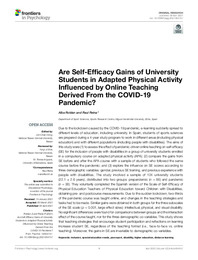Título :
Are Self-Efficacy Gains of University Students in Adapted Physical Activity Influenced by Online Teaching Derived From the COVID-19 Pandemic? |
Autor :
Roldan, Alba 
Reina, Raul  |
Editor :
Frontiers Media |
Departamento:
Departamentos de la UMH::Ciencias del Deporte |
Fecha de publicación:
2021-04-09 |
URI :
https://hdl.handle.net/11000/30821 |
Resumen :
Due to the lockdown caused by the COVID-19 pandemic, e-learning suddenly spread to different levels of education, including university. In Spain, students of sports sciences are prepared during a 4-year study program to work in different areas (including physical education) and with different populations (including people with disabilities). The aims of this study were (1) to assess the effect of pandemic-driven online teaching on self-efficacy (SE) for the inclusion of people with disabilities in a group of university students enrolled in a compulsory course on adapted physical activity (APA); (2) compare the gains from SE before and after the APA course with a sample of students who followed the same course before the pandemic; and (3) explore the influence on SE scores according to three demographic variables: gender, previous SE training, and previous experience with people with disabilities. The study involved a sample of 124 university students (22.1 ± 2.6 years), distributed into two groups: prepandemic (n = 86) and pandemic (n = 38). They voluntarily completed the Spanish version of the Scale of Self-Efficacy of Physical Education Teachers of Physical Education toward Children with Disabilities, obtaining pre- and postcourse measurements. Due to the sudden lockdown, two-thirds of the pandemic course was taught online, and changes in the teaching strategies and tasks had to be made. Similar gains were obtained in both groups for the three subscales of the SE scale (p < 0.001, large effect sizes): intellectual, physical, and visual disability. No significant differences were found for comparisons between groups and the interaction effect of the course taught, nor for the three demographic co-variables. This study shows that teaching strategies that encourage student participation and reflections on learning increase student SE, regardless of the teaching format (i.e., face-to-face vs. online teaching). Moreover, the gains in SE are invariable to demographic co-variables.
|
Palabras clave/Materias:
inclusion
special education needs
para-sport
disability
higher education
distance learning |
Área de conocimiento :
CDU: Bellas artes: Diversiones. Espectáculos. Cine. Teatro. Danza. Juegos.Deportes |
Tipo documento :
application/pdf |
Derechos de acceso:
info:eu-repo/semantics/openAccess
Attribution-NonCommercial-NoDerivatives 4.0 Internacional |
DOI :
https://doi.org/10.3389/fpsyg.2021.654157 |
Aparece en las colecciones:
Artículos Ciencias del Deporte
|
 La licencia se describe como: Atribución-NonComercial-NoDerivada 4.0 Internacional.
La licencia se describe como: Atribución-NonComercial-NoDerivada 4.0 Internacional.
.png)
